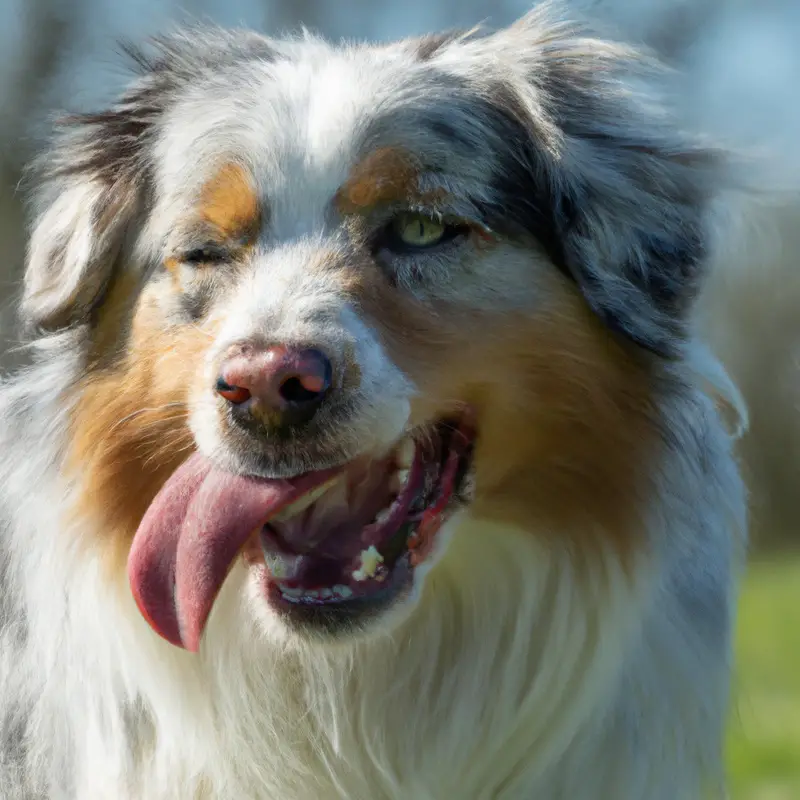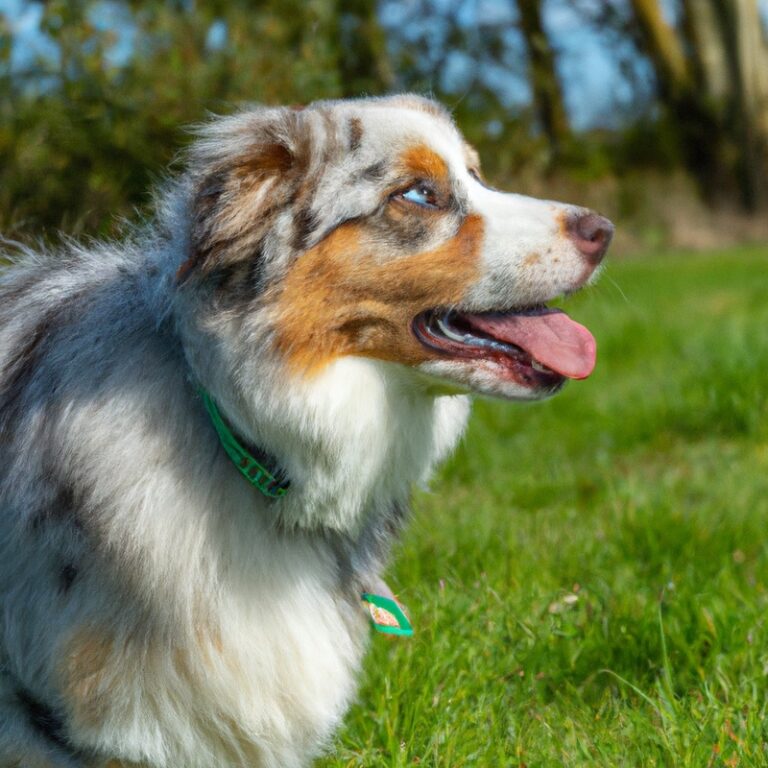Can Australian Shepherds Be Trained To Be Off-Leash?
Key Takeaways:
- While Australian Shepherds are highly intelligent and trainable, off-leash training requires consistency, patience, and a solid foundation of basic obedience commands.
- Early socialization and obedience training are crucial for teaching Australian Shepherds to respond reliably to off-leash commands and recall.
- The success of off-leash training for Australian Shepherds can vary depending on individual temperament, age, and previous training experiences.
- Regular practice, positive reinforcement, and gradual increases in freedom can help Australian Shepherds develop the necessary skills for off-leash reliability.
Are you ready to unleash the true potential of your Australian Shepherd? If you’re wondering whether these intelligent and energetic dogs can be trained to roam off-leash, you’ve come to the right place.
As a passionate dog trainer and proud owner of an Australian Shepherd myself, I can tell you that it is indeed possible.
In this blog, we’ll explore the origins and characteristics of this remarkable breed, as well as the importance of training and the best practices for off-leash training. Get ready to embark on an exciting journey filled with tips, techniques, and insights to help you achieve off-leash freedom with your furry friend.
| Criteria | Yes | No |
|---|---|---|
| Intelligence | High | – |
| Trainability | High | – |
| Temperament | Willful, independent | – |
| Energy Level | High | – |
| Reactivity to Environment | Varies | – |
| Recall Ability | Can be trained | Difficult |
| Prey Drive | High | – |
Understanding the Australian Shepherd breed
Origins and characteristics of Australian Shepherds
Australian Shepherds, also known as “Aussies,” are a breed that originated in the United States, despite the name. They were initially bred to work on ranches and herd livestock.
Aussies are known for their intelligence, agility, and versatility.
They have a medium-sized, muscular build and a thick, weather-resistant coat that comes in a variety of colors and patterns. These dogs are highly active and require plenty of exercise and mental stimulation to thrive.
Aussies have a strong herding instinct and may try to herd other animals or even people.
This instinct can make them excellent working dogs, but it also means they need proper training and guidance to prevent unwanted behaviors. Aussies are highly trainable and eager to please, making them quick learners.
They excel in activities such as obedience, agility, herding trials, and flyball.
In addition to their intelligence, Aussies are known for their loyalty and affection towards their families. They form strong bonds with their owners and are often protective.
However, they can be wary of strangers and need early socialization to ensure they are well-adjusted and friendly with new people and animals.
As a result of their herding background, Aussies are energetic dogs that require daily exercise to prevent boredom and destructive behavior. They thrive in active households where they can engage in activities such as hiking, running, and playing fetch.
Mental stimulation is equally important for Aussies, so puzzle toys and training sessions can help keep their minds occupied.
Overall, Australian Shepherds are intelligent, energetic, and loyal dogs that make great companions for active individuals or families. However, their high energy levels and need for mental stimulation mean they require dedicated training and an environment that can meet their exercise needs.
Energy levels and exercise needs of Australian Shepherds
Australian Shepherds are known for their high energy levels and need for regular exercise. These dogs are bred for herding livestock, so they have a natural drive to be active and work.
To meet their exercise needs, Australian Shepherds should engage in at least 60-90 minutes of physical activity every day.
This can include activities such as long walks, jogging, playing fetch, or participating in dog sports like agility or obedience training. Regular exercise not only helps Australian Shepherds release their energy but also keeps them mentally stimulated and helps prevent behavioral problems that can arise from boredom.
It’s important to keep in mind that Australian Shepherds thrive in environments where they have room to run and explore, so living in an apartment or a small space may not be ideal for this breed.
In addition to physical exercise, Australian Shepherds also benefit from mental stimulation. Providing them with puzzle toys, interactive games, and training sessions can help keep their minds sharp and prevent them from becoming bored and destructive.
These dogs are highly intelligent and enjoy learning new tasks, so incorporating training into their daily routine is essential.
When planning your Australian Shepherd’s exercise routine, it’s important to consider their individual needs and abilities. Some Australian Shepherds may have higher energy levels than others, so it’s important to adapt their exercise routine accordingly.
Be sure to consult with your veterinarian or a professional dog trainer to tailor an exercise plan that suits your dog’s specific needs.
By providing your Australian Shepherd with regular physical and mental stimulation, you can help ensure they lead a happy and balanced life. Remember, a tired dog is a well-behaved dog, so make sure to prioritize exercise and enrichment in your Australian Shepherd’s daily routine.

Importance of training for Australian Shepherds
Establishing a strong foundation through basic obedience training
Establishing a strong foundation through basic obedience training is essential for Australian Shepherds to excel in off-leash training. Obedience training helps them understand and respond to commands, and builds their focus and impulse control.
Through consistent training sessions, they learn to sit, stay, come, and walk nicely on a leash.
This foundation forms the basis for more advanced training and ensures a harmonious relationship between you and your Australian Shepherd. With patience, positive reinforcement, and consistency, you can establish a strong foundation that sets the stage for successful off-leash training.

Addressing behavioral issues and socialization for off-leash training
Addressing behavioral issues and socialization is key to successful off-leash training for Australian Shepherds. It’s important to start by understanding your dog’s unique temperament and any underlying behavioral issues.
This will help you tailor your training approach and address any specific challenges.
Proper socialization is essential for your Australian Shepherd to feel comfortable and confident in different environments. Expose your dog to various sights, sounds, and experiences from an early age.
This will help them develop good manners and reduce the likelihood of fear or aggression.
To address behavioral issues, it’s crucial to use positive reinforcement techniques. Reward your dog for desired behaviors such as coming when called and staying close by your side.
Consistency and patience are key.
If your dog is exhibiting unwanted behaviors, redirect their attention and provide an alternative, appropriate behavior to focus on. Additionally, consider seeking professional help if you’re struggling with behavioral issues or feel unsure about how to proceed.
A qualified dog trainer or behaviorist can provide guidance and support tailored to your dog’s specific needs.
Remember, each dog is unique, and off-leash training requires time, effort, and understanding. By addressing behavioral issues and focusing on proper socialization, you can set your Australian Shepherd up for success in off-leash training.
Keep practicing, stay positive, and enjoy the journey of building a strong bond with your furry friend.
Best practices for off-leash training
Recall training: Teaching the “come” command
Teaching your Australian Shepherd the “come” command is essential for their safety and your peace of mind. In recall training, the goal is to teach your dog to come to you when called, even in distracting situations.
Here are some tips to help you with this important command:
- Use positive reinforcement: The key to successful recall training is to make it a positive experience for your dog. Use treats, praise, and rewards to motivate them to come to you. Associate the command “come” with something enjoyable and rewarding.
- Start indoors: Begin the training in a quiet and familiar indoor environment with minimal distractions. Use a leash initially to guide your dog towards you and say “come” in a clear and upbeat tone. When they come to you, reward them immediately with praise and treats.
- Gradually increase distractions: Once your dog understands the command indoors, gradually move to outdoor spaces with more distractions. Start in a secure fenced area and practice recall with gradually increasing levels of distractions, such as toys, other dogs, or people.
- Practice in different locations: To solidify the “come” command, practice in different locations such as parks or walking trails. This will help your dog generalize the command and respond reliably regardless of the surroundings.
- Use long leashes or longlines: In the early stages of off-leash training, it can be helpful to use long leashes or longlines to give your dog freedom to roam while still being under control. This allows you to reinforce the “come” command if needed.
- Keep training sessions short and frequent: Training sessions should be short, frequent, and fun for both you and your dog. Aim for multiple short sessions throughout the day rather than one long session. This will help maintain your dog’s focus and prevent boredom.
- Be patient and consistent: Remember that training takes time and consistency. Be patient with your dog and celebrate even small victories. Consistency in your commands, rewards, and expectations will help your Australian Shepherd understand what is expected of them.
Positive reinforcement techniques for off-leash training
Positive reinforcement techniques are key when it comes to off-leash training for Australian Shepherds. It’s all about rewarding the desired behavior to encourage your dog to repeat it.
Here are a few techniques to try:
- Use treats: Reward your dog with a tasty treat every time they come to you when called or exhibit good behavior off-leash. Make sure to use high-value treats that your dog finds irresistibly delicious.
- Praise and affection: Besides treats, don’t forget to shower your Aussie with praise and affection when they listen to your commands and behave well while off-leash. Verbal praise, petting, and belly rubs can do wonders!
- Timing is key: Make sure to reward your dog immediately after they perform the desired behavior. This helps them associate the reward with their actions and reinforces the behavior you want from them.
- Consistency: Be consistent in your training approach and rewards. Use the same command words and gestures consistently so that your Aussie understands what is expected of them. This consistency helps them learn faster.
- Break it down: If your Australian Shepherd is struggling with off-leash training, break the training process into small steps. Work on mastering each step before moving on. This helps build their confidence and ensures success.
Remember, positive reinforcement keeps the training experience enjoyable for your Aussie and strengthens the bond between you. Stay patient, be consistent, and soon you’ll have a well-behaved and obedient off-leash Aussie!
Challenges and considerations for off-leash training
High prey drive and distractions: Managing and redirecting focus
High prey drive and distractions can pose challenges during off-leash training for Australian Shepherds. These dogs have a natural instinct to chase and may easily get distracted by moving objects or wildlife.
To manage and redirect their focus, I recommend using the following strategies:
- Use high-value rewards: Use treats or toys that your Australian Shepherd finds extremely rewarding. This will help keep their attention on you and reinforce positive behaviors.
- Teach a solid “leave it” command: Train your dog to respond to the “leave it” command, which can be useful in redirecting their attention away from potential distractions. Practice this command consistently in different environments.
- Practice impulse control exercises: Engage your Australian Shepherd in exercises that promote self-control, such as sitting and waiting patiently before receiving a reward. This will help them learn to resist the urge to chase or get distracted.
- Gradually expose to distractions: Start training in low-distraction environments and gradually increase the level of distractions over time. This will help your dog build the necessary focus and self-control to resist chasing or getting sidetracked.
- Use long-line training: During off-leash training, use a long line or retractable leash to maintain control while still giving your dog freedom to explore. This allows you to quickly regain control if they start to chase something.
- Engage in mental stimulation: Regularly provide mental stimulation activities, such as puzzle toys or scent work, to keep your Australian Shepherd’s mind engaged and reduce their focus on chasing or being distracted.
Remember, managing high prey drive and distractions requires patience and consistency. With time and proper training, you can help your Australian Shepherd develop the focus and self-control needed for successful off-leash training.
Safety precautions and gradual progression in off-leash training
When it comes to off-leash training for Australian Shepherds, safety should always be a top priority. Here are some important precautions to keep in mind:
- Start in a secure and controlled environment: Begin the training in an enclosed space, such as a fenced yard or a dog park, to minimize the risk of your dog running off or getting into dangerous situations.
- Use a long training lead: In the early stages of off-leash training, it’s helpful to use a long training lead attached to your dog’s harness. This gives you control over your dog’s movements while still allowing them some freedom to explore.
- Gradually increase distance and distractions: Gradually increase the distance between you and your dog, while also introducing distractions. Start with minimal distractions and gradually add more over time, ensuring that your dog remains responsive to your commands.
- Practice recall and other commands: Recall training is crucial for off-leash success. Consistently practice recalling your dog using a reliable command, such as “come,” and reward them generously when they respond promptly. Strengthen other basic commands like “sit,” “stay,” and “leave it” for better control.
- Assess your dog’s readiness: Every dog is different, so it’s important to assess your Australian Shepherd’s behavior and responsiveness to commands before granting off-leash freedom. If your dog consistently ignores commands or exhibits unsafe behavior, more training may be necessary before allowing off-leash activities.
Alternative options for exercise and stimulation
Enrichment activities and puzzle toys for mental stimulation
Enrichment activities and puzzle toys are great ways to mentally stimulate your Australian Shepherd. These activities help keep their intelligent minds engaged and prevent boredom.
One enrichment activity you can try is hiding treats or toys around the house or yard for them to find.
This taps into their natural instincts and allows them to use their problem-solving skills. You can also try interactive puzzle toys that challenge them to figure out how to get to a treat or toy.
Another option is to engage them in training sessions that involve learning new commands or tricks.
This not only provides mental stimulation but also strengthens the bond between you and your dog. Consider introducing your Australian Shepherd to new experiences and environments to keep their minds active.
Take them on walks in different locations, visit dog-friendly events or parks, or even arrange playdates with other dogs.
All of these activities expose them to new sights, sounds, and smells, stimulating their senses. Remember to rotate the toys and activities regularly to keep things interesting and prevent boredom.
Additionally, always supervise your dog during these activities to ensure their safety.
By providing enrichment activities and puzzle toys, you can keep your Australian Shepherd mentally stimulated and satisfied. This, in turn, can contribute to their overall well-being and help prevent behavioral issues that may arise from boredom or lack of mental stimulation.

Off-leash play in secure and controlled environments
Off-leash play in secure and controlled environments is an excellent way to provide exercise and mental stimulation for Australian Shepherds. These dogs are known for their high energy levels and intelligence, so they thrive in environments where they can run, explore, and interact with their surroundings.
When engaging in off-leash play, it’s crucial to ensure that the environment is secure and controlled.
This means having a fenced area or designated off-leash park where you can let your Australian Shepherd safely roam without the risk of running off or getting into danger. Secure and controlled environments also allow you to monitor and manage your dog’s behavior more effectively.
You can observe their interactions with other dogs and people, and intervene if necessary.
It’s a great opportunity to reinforce obedience commands and reinforce positive behaviors. During off-leash play, you can incorporate interactive toys, such as balls or Frisbees, to keep your Australian Shepherd engaged and mentally stimulated.
This helps prevent boredom and destructive behaviors.
Keep in mind that off-leash play is not suitable for all dogs. It depends on their temperament, training, and ability to follow commands.
If your Australian Shepherd is still in the early stages of training or tends to be highly reactive or aggressive towards other dogs, it may be best to stick to on-leash activities for now.
Evaluaing readiness for off-leash freedom
Assessing the dog’s overall behavior and responsiveness to commands
When it comes to assessing your Australian Shepherd’s readiness for off-leash freedom, it’s crucial to evaluate their overall behavior and responsiveness to commands. Start by observing their behavior in different environments, such as the home, neighborhood, and parks.
Do they display calm, focused behavior or are they easily distracted?
Next, assess their responsiveness to basic commands like “sit,” “stay,” and “come.” Are they able to obey these commands consistently, even when there are distractions around? This will give you an idea of their level of training and their ability to listen and follow instructions.
Pay attention to their recall skills as well.
Can they reliably come back to you when called, or do they tend to wander off or chase after something? A solid recall is essential for off-leash activities to ensure their safety and your peace of mind.
It’s also important to consider their temperament and socialization.
How do they interact with other dogs and people? Do they show signs of aggression or excessive fear?
A well-socialized and friendly Australian Shepherd is more likely to handle off-leash situations positively.
Remember, assessing your dog’s overall behavior and responsiveness to commands is just the first step in determining their readiness for off-leash freedom. Gradual transitioning and monitoring progress will be crucial in ensuring a successful and safe off-leash experience for both you and your furry friend.
Gradual transitioning to off-leash activities and monitoring progress
To ensure a successful transition to off-leash activities, it is important to take a gradual approach and closely monitor your Australian Shepherd’s progress. Start by practicing off-leash commands in a secure and controlled environment, such as a fenced yard or a designated off-leash area.
Gradually increase the level of distractions and challenges as your dog becomes more proficient in following your commands.
Keep a close eye on your dog’s behavior and responsiveness during off-leash activities. Are they consistently coming when called?
Are they staying close to you and checking in regularly?
Pay attention to any signs of disinterest, fear, or disobedience. If any issues arise, address them promptly and consider seeking professional help if needed.
It is also important to continually assess your dog’s readiness for off-leash freedom.
Every dog is different, and some may require more time and training than others. Regularly evaluate your dog’s overall behavior, recall skills, and ability to maintain focus and respond to commands.
If your dog consistently demonstrates good behavior and obedience, you can gradually increase the duration and complexity of off-leash activities.
Remember, transitioning to off-leash activities is a process that requires patience and consistency. By gradually increasing the level of freedom and monitoring your dog’s progress, you can ensure a safe and enjoyable off-leash experience for both you and your Australian Shepherd.
Final Verdict
Australian Shepherds can absolutely be trained to be off-leash companions, but it requires dedication, consistency, and a strong foundation of basic obedience training. By understanding their origins, energy levels, and exercise needs, we can tailor our training approach to meet their specific requirements.
Recall training and positive reinforcement techniques play a crucial role in establishing reliable off-leash behavior.
However, it is important to acknowledge the challenges, such as their high prey drive and distractions, and take appropriate safety precautions. With the right training and gradual progression, Australian Shepherds can enjoy the freedom of off-leash adventures while remaining responsive and obedient.







